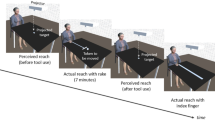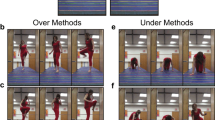Abstract
The current study investigated whether younger (college-age) and older adults (60+ years) differ in their ability to perceive safe and unsafe motor actions. Participants decided whether to walk through openings varying in width in two penalty conditions: In the doorway condition, if participants attempted to squeeze through impossibly narrow openings, the penalty for error was entrapment. In the ledge condition, if participants attempted to inch along impossibly narrow ledges, the penalty for error was falling. Results showed that across the lifespan, people consider falling to be a more severe penalty than getting stuck: Both younger and older adults made more conservative decisions when the penalty for error was falling, and older women were especially leery of falling. In both age groups, abilities and decisions were based on dynamic properties of the body, such as compressed body size in the doorway condition and balance in the ledge condition. Findings indicate that failure to perceive possibilities for action is unlikely to be the cause of the increased prevalence of falling in older adults.




Similar content being viewed by others
References
Adams P, Martinez M, Vickerie J, Kirzinger W (2011) Summary health statistics for the US population: National Health Interview Survey, 2010. Vital Health Stat 10:1–117
Butler A (2010) Action and ageing (Doctoral thesis, University of New South Wales, Sydney, Australia)
Cesari P, Formenti F, Olivato P (2003) A common perceptual parameter for stair climbing for children, young and old adults. Hum Mov Sci 22:111–124
Cornsweet TN (1962) The staircase-method in psychophysics. Am J Psychol 75:485–491
Fath AJ, Fajen BR (2011) Static and dynamic visual information about the size and passability of an aperture. Perception 40:887–904
Franchak JM, Adolph KE (2012) What infants know and what they do: perceiving possibilities for walking through openings. Dev Psychol 48:1254–1261
Franchak JM, Adolph KE (2013) Gut Estimates: pregnant women perceive possibilities for walking through doorways. Manuscript under review
Franchak JM, Adolph KE (in press) Affordances for action as probabilistic functions: Implications for development, perception, and decision-making. Ecol Psychol
Franchak JM, van der Zalm D, Adolph KE (2010) Learning by doing: action performance facilitates affordance perception. Vis Res 50:2758–2765
Franchak JM, Celano EC, Adolph KE (2012) Perception of passage through openings cannot be explained geometric body dimensions alone. Exp Brain Res 223:301–310
Gibson JJ (1979) The ecological approach to visual perception. Houghton Mifflin Company, Boston
Hackney AL, Cinelli ME (2011) Action strategies of older adults walking through apertures. Gait Posture 33:733–736
Hackney AL, Cinelli ME (2013a) Older adults are guided by their dynamic perceptions during aperture crossing. Gait Posture 37:93–97
Hackney AL, Cinelli ME (2013b) Young and older adults use body-scaled information during a non-confined aperture crossing task. Exp Brain Res 225:419–429
Hausdorff JM, Rios DA, Edelber HK (2001) Gait variability and fall risk in community-living older adults: a 1-year prospective study. Arch Phys Med Rehabil 82:1050–1056
Higuchi T, Cinelli ME, Greig MA, Patla AE (2006) Locomotion through apertures when wider space for locomotion is necessary: adaptation to artificially altered body states. Exp Brain Res 175:50–59
Ishak S, Adolph KE, Lin GC (2008) Perceiving affordances for fitting through apertures. J Exp Psychol Hum Percept Perform 34:1501–1514
Jaffe GJ, Alvarado JA, Juster RP (1986) Age-related changes of the normal visual field. Arch Ophthalmol 104:1021–1025
Konczak J, Meeuwsen HJ, Cress ME (1992) Changing affordances in stair climbing: the perception of maximum climbability in young and older adults. J Exp Psychol Hum Percept Perform 18:691–697
Larsson L, Grimby G, Karlsson J (1979) Muscle strength and speed of movement in relation to age and muscle morphology. J Appl Physiol Respir Environ Exerc Physiol 46:451–456
Lobjois R, Cavallo V (2007) Age-related differences in street-crossing decisions: the effects of vehicle speed and time constraints on gap selection in an estimation task. Accid Anal Prev 39:934–943
Lockhart TE, Woldstad JC, Smith JL, Ramsey JD (2002) Effects of age related sensory degradation on perception of floor slipperiness and associated slip parameters. Saf Sci 40:689–703
Lythgo N, Begg R, Best R (2007) Stepping responses made by elderly and young female adults to approach and accommodate known surface height changes. Gait Posture 26:82–89
Mark LS (1987) Eyeheight-scaled information about affordances: a study of sitting and stair climbing. J Exp Psychol Hum Percept Perform 13:361–370
Mark LS, Baillet JA, Craver KD, Douglas SD, Fox T (1990) What an actor must do in order to perceive the affordance for sitting. Ecol Psychol 2:325–366
National Center for Injury Prevention and Control CDC (2010) Web-based injury statistics query and reporting system (WISQARS) 2010
Nayak S, Roberts MS, Chang CH, Greenspan SL (2010) Health beliefs about osteoporosis and osteoporosis screening in older women and men. Health Educ J 69:267–276
Oudejans RR, Michaels CF, Bakker FC, Dolne MA (1996) The relevance of action in perceiving affordances: perception of catchableness of fly balls. J Exp Psychol Hum Percept Perform 22:879–891
Overstall P, Exton-Smith A, Imms F, Johnson A (1977) Falls in the elderly related to postural imbalance. Br Med J 1:261–264
Oxley J, Ihsen E, Fildes B, Charlton J, Day R (2005) Crossing roads safely: an experimental study of age differences in gap selection by pedestrians. Accid Anal Prev 37:962–971
Pitts DG (1982) The effects of aging on selected visual function: dark adaptation, visual acuity, stereopsis and brightness contrast. In: Sekuler R, Kline DW, Dismukes K (eds) Aging and Human Visual Function. A. R. Liss, New York, pp 131–159
Robinovitch S, Cronin T (1999) Perception of postural limits in elderly nursing home and day care participants. J Gerontol Ser A Biol Sci Med Sci 54:124–130
Rubenstein L, Josephson K, Robbins A (1994) Falls in the nursing home. Ann Intern Med 121:442–451
Schillings AM, Mulder T, Duysens J (2004) Stumbling over obstacles in older adults compared to younger adults. J Neurophysiol 94:1158–1168
Schoenborn CA, Adams PF, Barnes PM, Vickerie JL, Schiller JS (2004) Health behaviors of adults: United States, 1999–2001. Vital Health Stat 10:1–79
Stefanucci JK, Geuss MN (2010) Duck! Scaling the height of a horizontal barrier to body height. Atten Percept, Psychophys 72:1338–1349
Stel VS, Smit JH, Pluijm SMF, Lips P (2004) Consequences of falling in older men and women and risk factors for health service use and functional decline. Age Ageing 33:58–65
Stoffregen TA, Yang C, Bardy BG (2005) Affordance judgments and nonlocomotor body movement. Ecol Psychol 17:75–104
Suzuki M, Ohyama N, Yamada K, Kanamori M (2002) The relationship between fear of falling, activities of daily living and quality of life among elderly individuals. Nurs Health Sci 4:155–161
Tinetti ME, Speechley M, Ginter SF (1988) Risk factors for falls among elderly persons living in the community. N Engl J Med 319:1701–1707
Trommershäuser J, Maloney LT, Landy MS (2008) Decision making, movement planning, and statistical decision theory. Trends Cognit Sci 12:291–297
van der Meer ALH (1997) Visual guidance of passing under a barrier. Early Dev Parent 6:149–157
Vellas BJ, Wayne SJ, Romero LJ, Baumgartner RN, Garry PJ (1997) Fear of falling and restriction of mobility in elderly fallers. Age Ageing 26:189–193
Wagman J, Malek E (2009) Geometric, kinetic-kinematic, and intentional constraints influence willingness to pass under a barrier. Exp Psychol 56:409–417
Wagman JB, Taylor KR (2005) Perceiving affordances for aperture crossing for the person-plus-object system. Ecol Psychol 17:105–130
Warren WH (1984) Perceiving affordances: visual guidance of stair climbing. J Exp Psychol Hum Percept Perform 10:683–703
Warren WH, Whang S (1987) Visual guidance of walking through apertures: body-scaled information for affordances. J Exp Psychol Hum Percept Perform 13:371–383
Woollacott MH (1993) Age-related changes in posture and movement. J Gerontol 48:56–60
Zivotofsky A, Eldror E, Mandel R, Rosenbloom T (2012) Misjudging their own steps: why elderly people have trouble crossing the road. Hum Factors 54:600–607
Acknowledgments
This research was supported by National Institute of Health and Human Development Grant R37-HD33486 to Karen Adolph and a New York University Dean’s Undergraduate Research Fund Grant to Angela Char.
Author information
Authors and Affiliations
Corresponding author
Rights and permissions
About this article
Cite this article
Comalli, D., Franchak, J., Char, A. et al. Ledge and wedge: younger and older adults’ perception of action possibilities. Exp Brain Res 228, 183–192 (2013). https://doi.org/10.1007/s00221-013-3550-0
Received:
Accepted:
Published:
Issue Date:
DOI: https://doi.org/10.1007/s00221-013-3550-0




